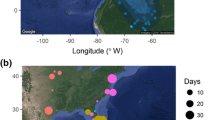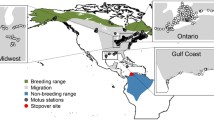Abstract
Whether or not a migratory songbird embarks on a long-distance flight across an ecological barrier is likely a response to a number of endogenous and exogenous factors. During autumn 2008 and 2009, we used automated radio tracking to investigate how energetic condition, age, and weather influenced the departure timing and direction of Swainson’s thrushes (Catharus ustulatus) during migratory stopover along the northern coast of the Gulf of Mexico. Most birds left within 1 h after sunset on the evening following capture. Those birds that departed later on the first night or remained longer than 1 day were lean. Birds that carried fat loads sufficient to cross the Gulf of Mexico generally departed in a seasonally appropriate southerly direction, whereas lean birds nearly always flew inland in a northerly direction. We did not detect an effect of age or weather on departures. The decision by lean birds to reorient movement inland may reflect the suitability of the coastal stopover site for deposition of fuel stores and the motivation to seek food among more extensive forested habitat away from the barrier.






Similar content being viewed by others
References
Able K (1972) Fall migration in coastal Louisiana and the evolution of migration patterns in the Gulf region. Wilson Bull 84:231–242
Able K (1982) The effects of overcast skies on the orientation of free-flying nocturnal migrants. In: Papi F, Wallraff HG (eds) Avian navigation. Springer-Verlag, Berlin, pp 38–49
Åkesson S (1993) Coastal migration and wind drift compensation in nocturnal passerine migrants. Ornis Scand 24:87–94
Åkesson S (1999) Do passerine migrants captured at an inland site perform temporary reverse migration in autumn? Ardea 87:129–137
Åkesson S, Karlsson L, Walinder G, Alerstam T (1996) Bimodal orientation and the occurrence of temporary reverse bird migration during autumn in south Scandinavia. Behav Ecol Sociobiol 38:293–302
Åkesson S, Hedenström A (2000) Wind selectivity of migratory flight departures in birds. Behav Ecol Sociobiol 47:140–144
Åkesson S, Walinder G, Karlsson L, Ehnbom S (2002) Nocturnal migratory flight initiation in reed warblers Acrocephalus scirpaceus: effect of wind on orientation and timing of migration. J Avian Biol 33:349–357
Alerstam T (1978) Reoriented bird migration in coastal areas: dispersal to suitable resting grounds? Oikos 30:405–408
Alerstam T (1988) Findings of dead birds drifted ashore reveal catastrophic mortality among early spring migrants, especially Rooks Corvus frugilegus, over the southern Baltic Sea. Anser 27:181–218
Alerstam T (1990) Bird migration. Cambridge University Press, New York
Alerstam T (2001) Detours in bird migration. J Theor Biol 209:319–331
Alerstam T, Lindström A (1990) Optimal bird migration: the relative importance of time, energy and safety. In: Gwinner E (ed) Bird migration: physiology and ecophysiology. Springer-Verlag, Berlin, pp 331–351
Bairlein F (1985) Efficiency of food utilization during fat deposition in the long-distance migratory garden warbler, Sylvia borin. Oecologia 68:118–125
Batschelet E (1981) Circular statistics in biology. Academic Press, New York
Berthold P (1996) Control of bird migration. Chapman and Hall, London
Biebach H, Friedrich W, Heine G (1986) Interaction of body mass, fat, foraging, and stopover period in trans-Sahara migrating passerine birds. Oecologia 69:370–379
Bolshakov C, Chernetsov N, Mukhin A, Bulyuk V, Kosarev V, Ktitorov P, Leoke D, Tsvey A (2007) Time of nocturnal departures in European robins, Erithacus rubecula, in relation to celestial cues, season, stopover duration and fat stores. Anim Behav 74:855–865
Buler JJ, Moore FR (2011) Migrant–habitat relationships during stopover along an ecological barrier: extrinsic constraints and conservation implications. J Ornithol 152:101–112
Buskirk W (1980) Influence of meteorological patterns and trans-Gulf migration on the calendars of latitudinal migrants. In: Keast A, Morton ES (eds) Migrant birds in the neotropics. Ecology, behavior, and conservation. Symposia of the National Zoological Park. Smithsonian Institution Press, Washington, DC, pp 485–491
Cimprich DA, Woodrey MS, Moore FR (2005) Passerine migrants respond to variation in predation risk during stopover. Anim Behav 69:1173–1179
Cimprich DA, Moore FR (1999) Energetic constraints and predation pressure during stopover. In: Adams J, Slotow RH (eds) Proceedings 22nd International Ornithological Congress. Bird Life South Africa, Durban, pp 834–846
Cochran WW, Kjos C (1985) Wind drift and migration of thrushes: a telemetry study. Bull Ill Nat Hist Surv 33:297–330
Cochran WW, Wikelski M (2005) Individual migratory tactics of New World Catharus thrushes: current knowledge and future tracking options from space. In: Marra P, Greenberg R (eds) Birds of two worlds. Princeton University Press, Princeton, pp 274–289
Dingle H (1996) Migration: the biology of life on the move. Oxford University Press, New York
Ellegren H (1991) Stopover ecology of autumn migrating Bluethroats Luscinia s. svecica in relation to age and sex. Ornis Scand 22:340–348
Emlen S (1980) Decision making by nocturnal bird migrants: the integration of multiple cues. Acta XVII International Ornithological Congress, Berlin, In, pp 553–560
Erni B, Liechti F, Underhill LG, Bruderer B (2002) Wind and rain govern the intensity of nocturnal bird migration in central Europe—a log-linear regression analysis. Ardea 90:155–166
Gauthreaux SA Jr (1971) A radar and direct visual study of passerine spring migration in southern Louisiana. Auk 88:343–365
Goymann W, Spina F, Ferri A, Fusani L (2010) Body fat influences departure from stopover sites in migratory birds: evidence from whole-island telemetry. Biol Lett 6:478–481
Heise C, Moore FR (2003) Age-related differences in foraging efficiency, molt, and fat deposition of Gray Catbirds prior to autumn migration. Condor 105:496–504
Helms C, Drury W Jr (1960) Winter and migratory weight and fat field studies on some North American buntings. Bird-Banding 31:1–40
Jenni L, Schaub M (2003) Behavioural and physiological reactions to environmental variation in bird migration: a review. In: Berthold P, Gwinner E, Sonnenschein E (eds) Avian migration. Springer-Verlag, New York, pp 155–174
Kays R, Tikak S, Crofoot J, Fountain T, Obando D, Ortega A, Kuemmeth F, Mandel J, Swenson G, Lambert T, Hirsch B, Wikelski M (2011) Tracking animal location and activity with an automated radio telemetry system in a tropical rainforest. Comput J 54:1931–1948
Kerlinger P, Moore FR (1989) Atmospheric structure and avian migration. Current Ornithol 6:109–142
Klaassen RHG, Alerstam T, Carlsson P, Fox JW, Lindström Å (2011) Great flights by great snipes: long and fast non-stop migration over benign habitats. Biol Lett 7:833–835
Kovach W (2011) Oriana user’s manual. Kovach Computing Services, Pentraeth, Wales, UK
Larkin RP, Raim A, Diehl RH (1996) Performance of a non-rotating direction-finder for automatic radio tracking of wildlife. J Field Ornithol 67:59–71
Liechti F, Bruderer B (1998) The relevance of wind for optimal migration theory. J Avian Biol 29:561–568
Liechti F (2006) Birds: blowin’ by the wind. J Ornithol 147:202–211
Lindström Å, Alerstam T (1986) The adaptive significance of reoriented migration of chaffinches Fringilla coelebs and bramblings F. montifringilla during autumn in southern Sweden. Behav Ecol Sociobiol 19:417–424
Mills AM, Thurber BG, Mackenzie SA, Taylor PD (2011) Passerines use nocturnal flights for landscape-scale movements during migration stopover. Condor 113:597–607
Moore FR (1984) Age-dependent variability in the migratory orientation of the Savannah sparrow (Passerculus sandwichensis). Auk 101:875–880
Moore FR (1987) Sunset and the orientation behaviour of migrating birds. Biol Rev 62:65–86
Moore FR, Kerlinger P (1987) Stopover and fat deposition by North American wood-warblers (Parulinae) following spring migration over the Gulf of Mexico. Oecologia 74:47–54
Moore FR, Kerlinger P (1992) Nocturnality, long-distance migration, and ecological barriers: In: Acta XX Congressus Internationalis Ornitholigici. Christchurch, New Zealand, pp 1122–1129
Moore FR, Mabey S, Woodrey M (2003) Priority access to food in migratory birds: age, sex and motivational asymmetries. In: Berthold P, Gwinner E, Sonnenschein E (eds) Avian migration. Springer-Verlag, New York, pp 281–292
Moore FR, Yong W (1991) Evidence of food-based competition among passerine migrants during stopover. Behav Ecol Sociobiol 28:85–90
Newton I (2007) The ecology of bird migration. Academic Press, London
Paynter R Jr (1953) Autumnal migrants on the Campeche Bank. Auk 70:338–349
Pennycuick CJ (1989) Bird flight performance: a practical calculation manual. Oxford University Press, Oxford
Perdeck A (1967) Orientation of starlings after displacement to Spain. Ardea 55:194–202
Pyle P, Howell S, DeSante D, Yunick R (1997) Identification guide to North American birds. Braun-Brumfield Inc, Bolinas
Raim A (1978) A radio transmitter attachment for small passerine birds. Bird-Banding 49:326–332
Ralph C (1978) Disorientation and possible fate of young passerine coastal migrants. Bird-Banding 49:237–247
Rguibi-Idrissi H, Julliard R, Bairlein F (2003) Variation in the stopover duration of reed warblers Acrocephalus scirpaceus in Morocco: effects of season, age and site. Ibis 145:650–656
Richardson W (1978) Timing and amount of bird migration in relation to weather: a review. Oikos 30:224–272
Richardson W (1982) Northeastward reverse migration of birds over Nova Scotia, Canada, in autumn. Behav Ecol Sociobiol 10:193–206
Salewski V, Schaub M (2007) Stopover duration of Palearctic passerine migrants in the western Sahara—independent of fat stores? Ibis 149:223–236
Sandberg R (2003) Stored fat and the migratory orientation of birds. In: Berthold P, Gwinner E, Sonnenschein E (eds) Avian migration. Springer-Verlag, New York, pp 515–525
Sandberg R, Moore FR (1996) Migratory orientation of red-eyed vireos, Vireo olivaceus, in relation to energetic condition and ecological context. Behav Ecol Sociobiol 39:1–10
Sandberg R, Moore FR, Bäckman J, Lõhmus M (2002) Orientation of nocturnally migrating Swainson’s thrush at dawn and dusk: importance of energetic condition and geomagnetic cues. Auk 119:201–209
Schmaljohann H, Naef-Daenzer B (2011) Body condition and wind support initiate the shift of migratory direction and timing of nocturnal departure in a songbird. J Anim Ecol 80:1115–1122
Smith RJ, Moore FR, May C, Lank DB (2007) Stopover habitat along the shoreline of northern Lake Huron, Michigan: emergent aquatic insects as a food resource for spring migrating landbirds. Auk 124:107–121
Stutchbury B, Tarof S, Done T, Gow E, Kramer P, Tautin J, Fox J, Afanasyev V (2009) Tracking long-distance songbird migration by using geolocators. Science 323:896
Taylor PD, Mackenzie SA, Thurber BG, Calvert AM, Mills AA, McGuire LP, Guglielmo CG (2011) Landscape movements of migratory birds and bats reveal an expanded scale of stopover. PLoS ONE 6:e27054
Woodrey M, Moore FR (1997) Age-related differences in the stopover of fall landbird migrants on the coast of Alabama. Auk 114:695–707
Acknowledgments
We regret the loss of our friend and colleague, Arlo Raim, who relentlessly radio tracked birds and died shortly after the conclusion of this study. Bill Cochran, Jim Cochran, and Tony Borries offered valuable technical support. Mason Cline, Kristin Comolli, Elizabeth Donadio, Erin Gnass, Joanna Hatt, Jennifer Mizen, Nikita Chernetsov, and members of the Migratory Bird Research Group provided important assistance in the field. Blanton Blankenship of Fort Morgan Historic Park and Jereme Phillips and Jackie Isaacs of Bon Secour National Wildlife Refuge provided access to habitats along the Fort Morgan peninsula used for netting and radio tracking. The USACERL provided the automated radio telemetry systems for use on this project. This work was supported by the U.S. Army Construction Engineering Research Laboratory (USACERL), The University of Southern Mississippi, Birmingham Audubon Society, and The American Ornithologists’ Union. Any use of trade, product, or firm names is for descriptive purposes only and does not imply endorsement by the U.S. Government.
Ethical standards
All research described herein complies with the laws of the USA.
Conflicts of interest
The authors declare that they have no conflict of interest.
Author information
Authors and Affiliations
Corresponding author
Additional information
Communicated by J. A. Graves
Rights and permissions
About this article
Cite this article
Smolinsky, J.A., Diehl, R.H., Radzio, T.A. et al. Factors influencing the movement biology of migrant songbirds confronted with an ecological barrier. Behav Ecol Sociobiol 67, 2041–2051 (2013). https://doi.org/10.1007/s00265-013-1614-6
Received:
Revised:
Accepted:
Published:
Issue Date:
DOI: https://doi.org/10.1007/s00265-013-1614-6




